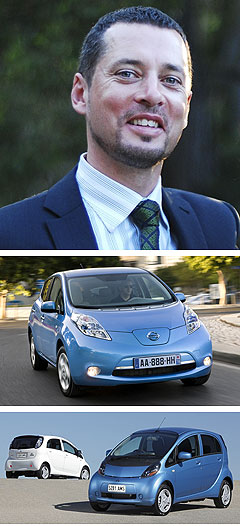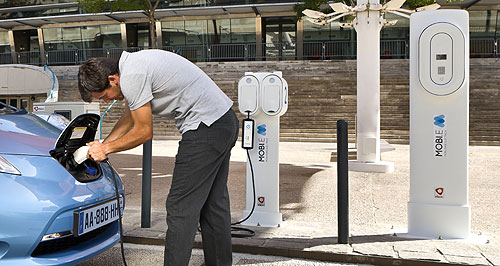Make / Model Search
News - General News - Electric VehiclesDrivers impressed by EVsQuick off the mark: Initial results from the Victorian Government’s electric vehicle trial show people are impressed by the performance of EVs. Government electric car trial finds that drivers appreciate performance8 Nov 2011 By IAN PORTER EARLY results from the Victorian Government’s electric vehicle trial indicate that, while you can take the combustion engine out of the car, you can’t take the need for speed out of the driver. The results show that many drivers quickly overcome their misgivings and doubts about the practicality of EVs after driving them for a little while. But the standout reaction from drivers is that they like the performance of EVs, particularly the acceleration, according to the Victorian trial’s manager, Kristian Handberg. “What is clear is that performance sells,” Mr Handberg told the ‘Plug in 4 Power’ seminar held at Melbourne’s Swinburne University of Technology yesterday. “The cars go very well they are surprisingly quick. “People go into the trial thinking the vehicles will be slow, but most of them have changed their minds now they have driven the cars. “The message we are getting is that they love driving the cars.” The Victorian EV Trial is being co-ordinated by the Victorian Department of Transport in a bid to learn what needs to be done to make the adoption of electric vehicles as seamless as possible, and to make Victoria an “electric vehicle-friendly place”. More than 60 organisations are involved, from vehicle producers, providers of charging infrastructure, energy providers, local councils and a range of private and corporate volunteers who will drive the vehicles for three months to gain ‘ownership’ experience.  Left Victorian EV trial manager Kristian Handberg. Below: Nissan Leaf and Mitsubishi i-MiEV. Left Victorian EV trial manager Kristian Handberg. Below: Nissan Leaf and Mitsubishi i-MiEV.The premier partners in the trial are the RACV, the CSIRO, AGL and Lumley Insurance. People wanting to participate in the next round should use the RACV website to apply when applications open again on November 26. Applications will be open for three weeks and the successful applicants will have the use of a car for three months at no cost. They will also have a recharging station installed at their house, which they can retain after the trial, or have it removed. The trial uses vehicles from Blade Electric Vehicles, EDay Life, Mitsubishi, Nissan and Toyota. There are 41 vehicles on the roads at present and a total of 60 are expected to be used in the trial. Mr Handberg said that, because of the self-selection aspect of the trial – people who volunteer to participate are probably already interested in EVs – it might be expected that reactions would be positive. Nevertheless, he said he was surprised at just how much attitudes changed. “We found 44 per cent of people said they would use an EV, even before they had driven one in the trial,” he said. “But, interestingly, that increases by 26 per cent to 70 per cent afterwards, indicating people are converted. They drive the cars and they think, ‘Well, I didn’t think I’d like it, but I do’. “That’s been an interesting finding. The technology sells itself. “When we ask them why their opinion changed, it was all about performance. That’s what is bringing people over. It’s not the feel-good factor. It’s not about status. It’s about how they feel about driving the car.” Mr Handberg said he was also surprised that ‘range anxiety’ quickly fades for some, although others remained concerned. “Range anxiety may be temporary,” he said. “Some of our participants over the three months of the trial didn’t feel they got comfortable with the limited range of the car. They actually felt like they needed more range. “That tells me it is going to be horses for courses. Not everyone is going to be comfortable with 100 kilometres.” However, he believes the car-makers would be able to address that problem. “They will be able to offer bigger batteries for more range at a cost. That will be an outcome.” Mr Handberg said a lot of work still needed to be done in drawing up parameters for recharging infrastructure in public places, a potential minefield that could quickly set the EV industry back if an accident happened. He said one difficulty at the moment was that car-makers were putting the recharging port at different places on their cars. “The routing for the recharging cable is different for each car. The Toyota Prius has its charging inlet on the front passenger side corner, the Leaf has it on the front of the car and the iMiev has it on the back driver’s-side quarter panel. They are completely different.” This makes it tricky when installing recharging points. “How will you locate the cable to avoid causing problems for pedestrians and cyclists?“If someone trips over on a busy street, falls into traffic and gets run over, you’ll never see a public charge point rollout again. We can’t afford to get these things wrong. “There is a lack of understanding out there. If you go to your building manager and say you want to install an EV charging station, he will automatically push back. “It’s not something he knows about. He will wonder about a lot of things. How much is this going to cost? Who is going to pay for the energy? Is it secure? Is someone going to be electrocuted? What happens after the trial? Am I left with the problem?“All of these issues have to be resolved.” While the EV trial will help resolve many issues and throw light on problem areas, Mr Handberg said a couple of crucial elements cannot be known. “The economic modeling tells us we are going to benefit from the adoption of EVs. The issues are how much and when?“The keys to accessing those economic benefits are oil prices and vehicle prices. If the prices of vehicles and batteries come down and oil prices come up, you will see the benefits of EVs come forward in terms of reaching a tipping point.” Mr Handberg said the early trial participants had demonstrated resourcefulness in figuring out their recharging requirements. He said all the cars in the trial had access to an electronic map showing the few public recharging stations located around Melbourne. As the Dandenong Council is a participant, a recharging point has been located on council land, but it is behind a gate. However, it shows up on the map as a public recharging point, which frustrated some EV drivers while others found a way around the problem. “They used a fruit box, put it against the fence and were able to reach a power point normally used to power a fast food van on the site,” said Mr Handberg. EDay Life founder Laurie Sparke, a former Holden engineering director, also addressed the seminar and afterwards indicated that his company’s plans to import a Chinese-built city car were on track. Dr Sparke will be going to China in two weeks to arrange the importation of the first vehicle, to be used by Federal authorities for certification tests. When approval is received, EDay Life plans to import an initial batch of 100 cars, some of which will be injected into the Victorian EV Trial, as well as other trials in Canberra and Shepparton.  Read more |
Click to shareGeneral News articlesResearch General News Motor industry news |










Facebook Twitter Instagram